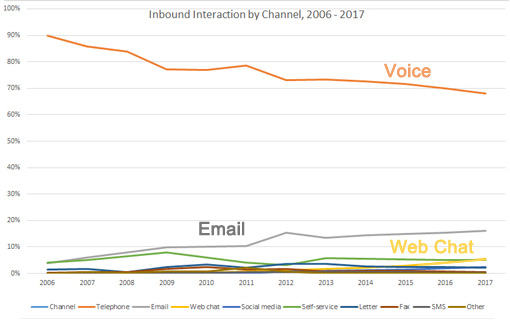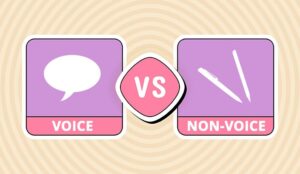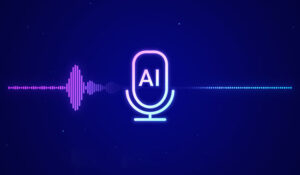We asked our panel about the role voice might play in the contact centre of 2034.
People will only call when they’ve exhausted all other options
For as long as humans have voices and are able to speak, contact centres will need to support voice.
People’s role as the best resource to interpret and react to complex “off-script” scenarios is unlikely to be challenged in the next 20 years.
But with more sophisticated self-service options becoming more widespread and customers increasingly turn to the internet first, people will only call a contact centre when they’ve exhausted all other options.
In response to this, agents will need to possess a higher level of skills to solve these problems.
They will need to think on their feet and rely much less on scripts, while the resources they do have access to will need to be as easily accessible as possible.
Consumers will make more calls while on the move
Far fewer calls will be made from the comfort of the home in 2034, as organisations find ways to serve their customers from alternative locations – such as in their stores or in other public places.

Stephen Wright
This will require contact centres to have the clearest audio possible, with inbound noise cancellation and audio enhancing technology.
Most contact centres will have video alongside voice
By 2034 we could expect most contact centres to have video as a major form of communication – alongside voice.
While video may not ever overtake voice due to the broader number of scenarios where video is not always practical, the unique quality to mimic face-to-face interaction – combined with the practical benefits that it can bring to industries such as retail and healthcare – will ensure that video enjoys tremendous success in the future.
With thanks to Stephen Wright at Azzurri Communications
Telephone interactions will become longer as voice evolves
Although channels such as social media, web self-service and chat will inevitably account for simpler transactional contacts, the expectation is that average telephone interactions will actually become longer as voice evolves.
Traditional telephony is already assuming a greater role as the de facto channel of escalation, with agents increasingly resolving those interactions that are perhaps too complex for newer channels.
Web-enabled voice is already starting to impact consumers
For a technology that some say has changed very little over the last 100 years, many now expect the next decade to see a revolution in voice technology – one that could potentially alter its very definition.
Web-enabled voice is already starting to impact consumers. With the accelerated roll-out of broadband, the UK is now moving more quickly towards ubiquitous high-speed Internet access, making services such as Skype a reality for more than just metropolitan customers.
Similarly, with Google now surfacing phone contact details in its search results, customers are going to be able to contact organisations directly from their web browsers.
With the wider integration of click-to-dial services, this search evolution has the potential to divert significant volumes of traffic from pages that can currently account for between 20-25% of corporate site visits.
WebRTC may lead to the death of the traditional phone number

Stuart Dorman
With innovations such as WebRTC, the growth of the Audible Web and the development of High Definition Audio, it’s clear that a major shift in voice technology is coming – perhaps even leading to the death of the traditional phone number.
In this world, interaction metadata goes far beyond the basic caller ID offered by inbound voice calls, offering context, location and a rich multi-media environment in which to deliver customer service.
The next few years will see the customer services industry getting excited about voice again. Now is the time to start thinking about what this will mean for your business.
With thanks to Stuart Dorman, Head of Consulting at Sabio
The death of voice isn’t coming at any time soon
The death of voice as a communication channel within the contact centre isn’t coming at any time soon!
There is no denying that the contact centre is increasingly moving to multi-channel, as customers demand different options for contacting support teams or even facilitating the resolution of the problem themselves.
However, when a customer has a complex or immediate issue they will automatically reach for the phone in order to speak to someone who can help there and then. This will not change in the future; however, the nature of the enquiry will start to dictate which channel is used.
The era of the multi-skilled Super Agent is about to start
In the future we will see the development of Super Agents, who will undertake a high level of product or service training in order to resolve detailed or multifaceted issues. They may also be the conduit that liaises with other departments to provide a comprehensive service that delivers an effective resolution.

Amanda Bowbanks
In addition to this, the Super Agent could also add more value in the future by being strategic and sourcing customer intelligence for marketing purposes or up-selling where relevant whilst on an inbound call, or even undertaking outbound calling to follow up on a resolved issue or to create sales opportunities at the end of a warranty period.
This evolution of voice in the contact centre will allow customer service departments to become the heart of an organisation – with their Super Agents being the ultimate solution provider, lead generator or marketing-intelligence gatherer.
With thanks to Amanda Bowbanks at Jabra
The telephone will be used more intelligently alongside other channels
With 85% of generation Y using a smartphone as their main form of communication, there is no doubt that by 2034 the majority of contact centre interactions will be text based – be it email, messaging or social.
Nevertheless, the need for telephone customer service will still exist.
However, instead of the telephone being the default inbound channel it has always been, it will start being used more intelligently alongside other channels.

Susannah Richardson
What will change will be that automation will start to play a much larger part in filtering incoming text-based communication and providing automated response for a large volume of simple requests.
More complex responses will be routed to a live agent, who will either message the customer back or proactively phone the customer’s smartphone.
For complex requests phone will still be far more efficient and will add benefits such as up-sell and cross-sell. However, the telephone will transition from an inbound customer channel to an outbound agent channel to respond to and resolve complex inbound text enquiries.
With thanks to Susannah Richardson at mplsystems
It’s difficult to see complex queries not being dealt with by a human being
For many customers, the call centre has become the last resort. They have searched online and not found a solution, so they pick up the phone and inevitably go through call routing to speak to an agent about their ‘miscellaneous’ query.
It is difficult to imagine these queries being dealt with any way other than by a human being. However, if you look at the kind of data-based contextualisation that Google uses for Google Now, for instance, it starts to seem more feasible.
Using previous searches, phone contacts, Gmail and location data, Google can tell me the quickest route home from work when I need it, the latest scores from the match my favourite football team played that afternoon and when I can expect a parcel to be delivered.
Is it possible that that kind of data could be joined up in the contact centre in order for machines to understand and contextualise customer issues?
We already have CRM integration in order to implement intelligent call routing to direct calls through the most appropriate agents and ensure they know as much about the customer as possible.
Could we be looking at a future when the contact centre agent is unnecessary, and ‘voice’ as a channel is completely automated? Or largely automated, with contact centre agents with more developed skills handling only the most specialised of customer interactions?
The future of the phone might be under threat
Voice will always have a place in the contact centre, as our stable communication form is verbal. However, the future of the phone might be under threat.
Voice recognition has a patchy history when it comes to use in the contact centre. Experiences have been bad and historically the technology used for voice recognition has been terrible.

David Ford
However, as the world’s most powerful technology brands invest in this area, the technology is improving hugely and consumers are getting more familiar with the idea of talking to a device rather than a person.
If voice recognition with this level of sophistication could be introduced in the contact centre, it might have the potential to revolutionise how calls are managed. It may be the case one day that customers don’t even know that they are talking to a machine.
With thanks to David Ford, Managing Director at Magnetic North
People will still want the reassurance of speaking to another person

Steve Morrell
Voice will remain the channel of choice for complex and multiple interactions, due to the opportunity for quick-fire Q&A branching into different subject areas, the superior speed of speech over typing and the reassurance of speaking to another person.
I can see self-service branching into e2e interactions, with software agents belonging to the customer and the business communicating without the direct input of agents.
With thanks to Steve Morrell at ContactBabel

This ContactBabel Graph shows a slight decline in telephone communication – and an increase in email, webchat and self-service.
Voice will be a major channel for complex problems
I think voice (possibly alongside video) will be a major channel for complex problems for a while yet – unless we all lose the ability to talk.
We are wired to be social. Verbal communication is a natural form of communication that we have evolved to use efficiently and effectively – but it may well be used only if we really need that human touch.
With thanks to Dr Nicola J. Millard, Head of Customer Insight & Futures at BT
Find more up-to-date thoughts from Nicola regarding the future of the voice channel in our article: The Contact Centre of the Future: Customer Trends Shaping the Contact Centre
Voice will never disappear because humans are built to have relationships
Voice will continue to decrease as a percentage of overall interactions, but it will never disappear. This is because humans are built to have relationships with other humans.
But the voice channel can certainly be enhanced with ‘voice-plus’ services. For example, voice plus co-browsing, voice plus video, etc. These are available now and I’m sure others will arrive in years to come.
Straightforward interactions will continue to be diverted to self-service

Jamie Stewart
Straightforward interactions will continue to be diverted to self-service and text-based channels. These alternatives are important and are driven by customer demand for speed, convenience and low cost.
They will continue to evolve in sophistication, becoming ever more like face-to-face interaction, with sentiment detection and other nuances. But, like the quest for artificial intelligence, they will never quite get there.
Try as we might, voice and its emotional, empathic qualities will never be replaced. We are, after all, only human.
With thanks to Jamie Stewart, Marketing Manager at Sytel Limited
Social media may challenge voice as the preferred contact channel
Today, voice is still the channel of choice for a quick response – selected by 66% of UK consumers in our 2013 ‘Serial Switchers’ research – but organisations need to look to the future and prepare for the next generation of customer service.
The research highlighted the generational importance of social media as a contact channel, and it’s likely to explode in relevance as Gen Y consumers’ spending power increases.
By 2034, social media may challenge voice as the preferred contact channel, but voice will always be the best way of handling the most urgent and complex of queries – and the fastest way to get an answer.
With thanks to Jonathan Gale, CEO at NewVoiceMedia
The majority of interactions will move away from voice
There’s no doubt that the majority of interactions between a company and a customer will move away from voice within the next twenty years.
The poor public perception of ‘call centres’ and the rise in smartphone apps has created a perfect storm of customers moving to self-service, web chat and self-help through forums – anything to get away from the hold music and endless transfers which call centres are associated with.
A call to an organisation will be defined as an escalated query
Yet when there’s a really complex request, we will want to speak to someone quickly – and that person had better be knowledgeable and empowered to resolve our issue!

Richard Kenny
Currently the first reaction is to escalate this to supervisors or team leaders, but in 20 years’ time the call to your organisation will be the escalation. Voice will be used less often but each of those calls will be significantly more important than the routine calls we have today, and so will need to be crystal clear to ensure no mistakes.
This will be your new marketing in 2034 as, by ensuring both your self-service and any subsequent calls deliver exactly what your customers want, they will spread the word through their social networks and do your marketing for you.
With thanks to Richard Kenny, EMEA Marketing Manager at Plantronics
Voice will continue to grow in importance
As the prevalence of high street and ‘face-to-face’ has declined, e-commerce and the web has increased the need for voice in terms of sales and service in support – especially with smartphones allowing you to do everything while you roam.
While webchat will probably eclipse email in the next decade, voice will continue to grow in importance – enhanced by video chat.
At the end of the day, consumers will decide. But if the digital revolution of the last decade is anything to go by, it will be increasingly cheaper and easier to talk and to bring people together ‘virtually’, but still personally.
With thanks to Simon Beeching at Syntec
Customers will still require assistance only humans can provide
Organisations are under pressure to ensure that customers only have to expend minimum effort, as busy modern lifestyles take priority.
While this may bring a decline in inbound calls to contact centres, customers will still require assistance that only human interaction can provide.
For example, if a customer is having a technical issue that they do not fully understand, they’re going to need a detailed explanation to help them.
Communicating through social media or SMS has limitations on the amount of detail you can describe; 140 characters on Twitter may not be enough to discuss a complicated technical fault.
Customers will always appreciate a friendly conversation
Having a person explain issues to you in a friendly and simple manner is something that customers really appreciate, and that will never change.

Paul Thomas
While some contact centres may go fully automated by 2034, I believe there will always be a place for the voice.
It’s easy to be swept away with technology and its related cost savings, but companies that recognise the inherent need for the human touch will be able to provide better customer experiences.
With thanks to Paul Thomas, Senior VP Northern Europe at Aspect Software
A phone call can help the agent empathise and respond appropriately
Hearing someone else’s voice is a much more personal experience. A phone call can easily convey a customer’s emotions and help the agent empathise and respond appropriately.
Such nuances aren’t always conveyed in email and are next to impossible in a tweet or direct message limited to 140 characters.
Voice communication is often the easiest
Even though an increasing number of people will likely turn to social media or webchat for quick questions or minor issues, when a customer has a lot of information to get across, a phone call will still be the best option.
The development of IP telephony has also allowed contact centres to handle extremely high call volumes while maintaining the highest levels of voice quality.
Some customers will still be more comfortable with a phone call
The balance between voice calls and other communication channels must be managed carefully.
Some customers will still be more comfortable handling their query with a phone call if other channels such as social media feel new or unfamiliar to them.
Contact centres must be able to maintain a seamless dialogue
It seems that the contact centre of the future might rely less on telephone calls and more on other channels of communication, but these centres will need to incorporate each simultaneously from one interface.
A good contact centre will manage one issue over multiple channels to inspire confidence in their customers.
With thanks to Martyn King, Managing Director at Nexbridge
Consumers and professionals would still rather speak to a live agent
Modern consumers take a multi-pronged approach when communicating with companies and, as the number of alternative channels widens, social media, webchat and video chat are starting to catch-up with the popularity of traditional communication methods.
One of the most interesting findings of our annual Global Customer Service Survey, however, is the fact that both consumers and professionals would still rather speak to a live agent via phone over any other interaction channels.
We could see wearable technology that encompasses voice in some way
With the move towards a customer service approach that focuses on self-service, it is fair to say that the role of the traditional telephone will diminish.

Dave Paulding
That said, smartphones could give way to smart accessories and wearable technology that will no doubt encompass the use of voice in some way.
So while the conventional idea of a phone may wane in popularity, voice still definitely has a role to play – whether it is in actually talking to another person or even answering automated responses with a view to customers solving their own issues.
With thanks to Dave Paulding, Regional Director UK and Middle East at Interactive Intelligence
More and more queries will be handled by self-service
As technology advances, more and more queries will be handled by self-service, and identification and verification processes will be increasingly automated as younger generations in particular become more comfortable with receiving automated help.
This evolution may give rise to an “expert” call centre agent, as customers will only require to talk to an agent when a query is more complex.
Instant video chat may be the norm by 2034
We have already seen this in the form of the ‘Mayday’ button on Kindle Fire.
If a customer needs help, they press the ‘Mayday’ button and an Amazon customer service agent will pop up and solve their problem via video chat.
It’s quick and efficient, and may even be the norm in 2034 rather than a novelty.
Voice biometrics software may replace the standard security-check
Technology is growing all the time, so by 2034 voice biometrics software may be reliable enough to totally replace the standard security-check questions people get asked when calling contact centres.
Voice biometrics records a unique imprint of a caller’s voice, and since all voices are unique, they can be analysed by software that can quickly determine authenticity.
While their reliability is questioned today, technology may have advanced enough that they are more reliable than security-check questions.
Businesses will need to adapt to stay ahead of the competition

Richard McCrossan
As voice is still the customer’s preferred contact method, it is clear that it will still play a part in the call centre of 2034.
How big a part and for which applications depends very much on how voice technologies develop. What is certain is that businesses will need to adapt their voice solutions in order to stay ahead of the competition, and to provide a great customer experience.
With thanks to Richard McCrossan, Strategic Business Director at Genesys
Author: Megan Jones
Published On: 20th Aug 2014 - Last modified: 12th Nov 2024
Read more about - Technology, Alvaria, ContactBabel, David Ford, Editor's Picks, Genesys, IFS, Intrado, Jabra, Jonathan Gale, Maintel, Nexbridge, Nicola Millard, Poly, Predictions, Richard Kenny, Richard McCrossan, Sabio, Steve Morrell, Susannah Richardson, Syntec, Sytel, Vonage






















Undoubtedly Ultra HD Video or similar will be the main channel of communication between peers by 2034 but will consumers always want to have a video interaction with a company? Obviously the context of the initiation is important, but for instance would they mind that company holding their image or video to undertake facial / voice / behavioral recognition, would they mind the whole video session being “recorded for training and quality purposes” only to be picked over by video analytical software examining every facet of the customers facial gesture and body language trying to determine how close the agent came to securing the sale for that new shiny hover car or bike, how likely the customer is to buy if approached again with refined elements of the pitch, perhaps the agent might even be coached by the software in real time.
I suspect that like today where we have seen a backlash against Social Media Networks, Companies and even Governments on Privacy, “Voice Only” contact will be perceived as the most “emotively secure” means of interaction to be had with companies, perhaps only for 1st or 2nd contact until a level of trust is established and for that reason I think that HD Voice still has a very large role to play in the Contact Center of 2034 and beyond.
Haven’t read all the good observations about the role of “voice” for customer assistance. However, let’s NOT confuse voice and telephony as a mode of contact, because we will see more “contextual,” flexible contacts and IP connections from multimodal smartphones and tablets replacing the PSTN and “blind,” calls from voice-only telephones.
Business communications really require people to exchange visual information during a conversation, not just talk!
Great insight. Given the recent rise in customer service provision from more agile, home based agents the use of traditional “bricks and mortar” contact centres is also likely to undergo a dramatic transformation. The roll out of super fast broadband across the UK and the adoption of enabling cloud apps are already driving this evolution.